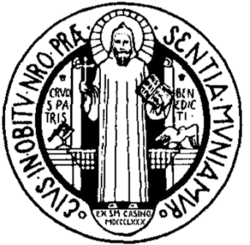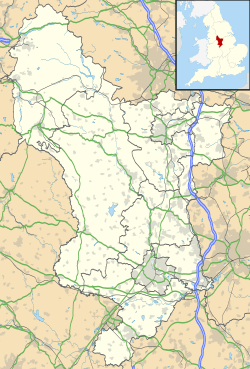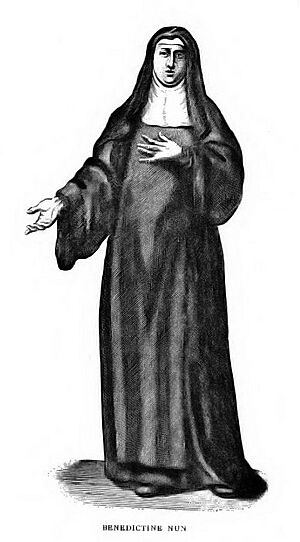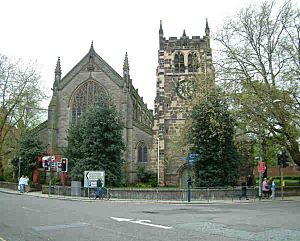King's Mead Priory facts for kids

Saint Benedict Medal
|
|
| Monastery information | |
|---|---|
| Full name | The Priory of St. Mary de Pratis |
| Other names | The Priory of St. Mary by Derby The Priory of the Blessed Mary juxta Derby. |
| Order | Benedictine Nuns |
| Established | c. 1160 |
| Disestablished | 1536 |
| Mother house | Darley Abbey (until around 1250) |
| Dedicated to | St Mary de Pratis: St. Mary of the Meadows |
| Diocese | Coventry and Lichfield |
| Controlled churches | St Werburgh's Church, Derby |
| People | |
| Founder(s) | Abbot Albinus of Darley Abbey |
| Site | |
| Location | Near Derby |
| Coordinates | 52°55′35″N 1°29′21″W / 52.92646°N 1.48918°W |
| Visible remains | None |
King's Mead Priory was a special kind of monastery for Benedictine nuns. It was located west of Derby, in an area now called Nun's Street or Nun's Green. This priory was the only Benedictine nunnery in the whole of Derbyshire.
The priory was named "St Mary de Pratis," which means St. Mary of the Meadows. It became a very popular place for important families in Derbyshire to send their daughters. They would go there to get an education.
Contents
The Priory's Story
King's Mead Priory was started around 1160. It was founded by Abbot Albinus from the nearby Darley Abbey. The priory was about a mile from Darley Abbey, west of Derby. It was built "in a meadow by the side of the Oddebrook" stream. Walter Durdent, who was the Bishop of Coventry at the time, placed the priory under the abbot's care.
During building work in the early 1800s, people found signs that the area might have been a Roman bathhouse. It's not clear if anything from these older buildings was still there when the priory was founded.
The priory was home to a group of Benedictine nuns. It was dedicated to "St. Mary de Pratis" and was first controlled by Darley Abbey, its main monastery.
The first leader of the nuns, called a Prioress, was named Emma. Soon after the nunnery began, a warden was appointed. The first warden was William de Bussel. The priory received some of its money from King Henry III. He ordered that five pounds be paid to the nuns each year from Nottingham farm rents. In return, the nuns would say prayers for Henry's father, King John.
Becoming Independent
King's Mead Priory and its parent monastery, Darley Abbey, started to have problems. They disagreed about gifts and money given to King's Mead. The arguments became so bad that Roger Weseham, the Bishop of Coventry and Lichfield, had to step in around 1250.
He helped them reach an agreement. This agreement made the nuns at King's Mead, and their property, free from the control of Darley Abbey. Their property was clearly divided. It was decided that Darley Abbey would have "no right and no power" over the priory and its land.
In these talks, the nuns at King's Mead gained several properties. These included St Werburgh's Church, Derby, land near Mackworth, a mill, and some houses in Derby. In return, the nuns gave Darley Abbey some land in Scarcliffe and Langwith.
Priory Finances
During the time of King Edward I (1272-1307), the priory earned about £14 each year from its properties in Derby. They also earned more money from their three mills on the Oddebrook stream. At this time, the priory also controlled the areas of Aldewerk, Normanton, Botterleg, and Wytunton. The priory's garden and nearby land were valued at 20 shillings a year.
The priory asked the king for help because they were poor. They said they had too many visitors to entertain. On September 2, 1327, King Edward III gave the monastery "special protection" for three years. This was to help with their property and debts. They had faced "unusually heavy mortality amongst their cattle" and "badness of the past few years." Robert of Alsop and Simon of Little Chester were chosen to look after the priory, as the nuns wished.
Even seven years later, the priory still seemed to be in debt. The bishop mentioned the nuns' poverty in his letters when he appointed a new Prioress in December 1334.
Also during King Edward III's reign (1327-1377), the Prioress paid £30 for a special permission. This allowed the priory to own 10 messuages (houses with land), a mill, four shops, six cottages, 50 acres of land, and 10 acres of meadow.
King Henry IV (1399–1413) confirmed that the priory would continue to receive 100 shillings each year from the town of Nottingham. He also granted them 27 acres of land in the Peak forest.
A Prioress's Strong Words
During the time of King Henry VII (1485-1509), the Abbot of Burton Abbey complained to the Chancery Court. He said that the Prioress of King's Mead, Isabel de Stanley, had refused to pay him rent for 21 years.
When the Abbot's helper came to collect the money, Prioress Isabel reportedly said:
"Do these common people think they can boss me around or sue me? They wouldn't dare, or they'll pay with their bodies and be shot with arrows! I am a noblewoman from the greatest families of Lancashire and Cheshire; and they will know that very well."
Isabel de Stanley was related to a nobleman who had married the mother of King Henry VII.
In November 1509, Geoffrey Blythe, the Bishop of Coventry and Lichfield, sent his helper Thomas Weell to help a nun named Joan Hethe. She wanted to live a solitary life in a chapel at Macclesfield.
In 1535, a survey called the Valor Ecclesiasticus recorded the priory's yearly income as £21 18s 8d. After expenses, £18 6s 2d remained. They also got an extra 40 shillings a year from St Werburgh's Church, Derby. This small income was often why the priory had money problems. They also earned money by teaching and housing female students from local noble families.
The priory never seemed to fix its money problems. During the reign of King Henry VIII (1509-1547), the priory was recorded as having a debt of 20 marks.
After the Priory Closed
The Priory was officially closed down in 1536 as part of the Dissolution of the Monasteries in England.
The land where the priory stood was given to Francis Talbot, 5th Earl of Shrewsbury in 1541. He then sold it to Thomas Sutton in 1542. The land was passed down through the Sutton family and later to Sir Simon Degge.
In 1825, Francis Mundy owned the priory site. He built new streets and houses there. In March 1825, during this work, builders found a stone coffin less than two feet underground. It held the bones of a small woman. The coffin was accidentally broken when it was found, so it wasn't kept. Bits of human bone were also found nearby.
A "tessellated pavement" was also discovered. This was a floor made of multi-coloured three-inch square tiles. It measured nine feet by four feet and had old foundation stones around it. People thought this was part of a Roman (or possibly Saxon) bathhouse.
Today, nothing remains of the priory buildings. The area is now called Nun's Meadow and Nun's Street and has many modern buildings. Some of the old priory stones might have been used in other local buildings.
Important Prioresses
Many of the Prioresses, the leaders of King's Mead Priory, came from important families in Derbyshire. This shows that many noble families sent their daughters here for their education.
- Emma, around 1160
- Margaret, early 1200s
- Emma II, around 1230
- Raimon, early 1200s
- Rametta, around 1236
- Sibilla, around 1258
- Ellen de Beresford, resigned in 1334
- Joan Touchet, appointed 1334, died in 1349
- Alice de Ireland, appointed 1349
- Elizabeth Stanley, around 1431, died 1457
- Elizabeth Mackworth, 1457-1487
- Margaret Cholmeley, appointed 1487
- Isabel de Stanley, during the reign of Henry VII
- Elizabeth, around 1514
- Alices Knowles, died 1531
- Joan Curzon, appointed 1531
Images for kids





